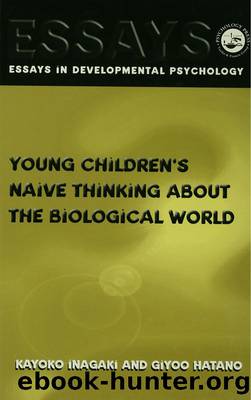Young Children's Thinking about Biological World by Hatano Giyoo;Inagaki Kayoko;

Author:Hatano, Giyoo;Inagaki, Kayoko;
Language: eng
Format: epub
Publisher: Taylor & Francis Group
When Taro is served a cake at snacktime, he eats it at once. Why does he do so? (a) Taro wants to eat the cake [intentional], (b) Taroâs mouth wants to eat the cake [vitalistic].
An example of the questions about biological phenomena is as follows:
Taro eats meal three times a day. Why does he do so? (a) Because Taro wants to eat tasty food [intentional explanation], (b) Becuase Taroâs tummy takes in vital power from the food [vitalistic explanation].
The questions on biological phenomena and those on psychological ones were mixed together, randomly ordered, and given in a fixed order for all the children. Half of the children were presented the alternative of a personâs intention (i.e., intentional causality) first, and the other half, the alternative of a body partâs agency and intention (vitalistic causality) first.
Results indicated that the children preferred intentional to vitalistic causal explanations in the case of psychological phenomena. In other words, these children seldom chose vitalistic explanations (i.e., those ascribing the phenomena to the relevant bodily parts) in the case of psychological phenomena. For biological phenomena, however, they preferred the vitalistic to the intentional explanations, like their agemates in the previous experiment. Intentional explanations were chosen a little more often for biological phenomena than in the previous experiment, probably because the children were required to make choices without being presented with âscientificâ (mechanical) explanations.
In order to examine individual patterns, we selected those children who (a) made more intentional than vitalistic choices for both psychological and biological phenomena, that is, chose intentional explanations four or more times for the six psychological items and three or more times for the five biological items (I-I pattern); (b) made more intentional than vitalistic choices for psychological phenomena but more vitalistic than intentional choices for biological ones (I-V pattern); (c) made more vitalistic than intentional choices for psychological ones but more intentional than vitalistic choices for biological ones (V-I pattern); and (d) made more vitalistic than intentional choices for both types of phenomena (V-V pattern). If children tended to prefer vitalistic explanations to intentional ones due to the novelty of vitalistic explanations, V-V patterns would have occurred most often. However, this pattern was seldom found. (I-I patterns were not found, either.) Instead, a great majority of the children showed an I-V pattern, that is, choosing intentional explanations for psychological phenomena and vitalistic ones for biological phenomena. The differences in frequencies between the I-V pattern and the V-I pattern were significant by a binomial test.
These results showed that vitalistic explanations were not always attractive to the children. Moreover, the results suggest that the children applied intentional and vitalistic causalities differentially to biological and psychological phenomena. However, many competing interpretations are possible for differential application, because the pairs of explanations (intentional vs. vitalistic) used in this experiment were not comparable between psychological and biological items. It could be suggested, for example, that the vitalistic explanations for psychological phenomena were often rejected because (a) while most vitalistic explanations for biological phenomena described what the body
Download
This site does not store any files on its server. We only index and link to content provided by other sites. Please contact the content providers to delete copyright contents if any and email us, we'll remove relevant links or contents immediately.
The Art of Thinking Clearly by Rolf Dobelli(8869)
The 5 Love Languages: The Secret to Love That Lasts by Gary Chapman(8530)
Mindhunter: Inside the FBI's Elite Serial Crime Unit by John E. Douglas & Mark Olshaker(7850)
Becoming Supernatural by Dr. Joe Dispenza(7121)
The Road Less Traveled by M. Scott Peck(6650)
Nudge - Improving Decisions about Health, Wealth, and Happiness by Thaler Sunstein(6644)
Enlightenment Now: The Case for Reason, Science, Humanism, and Progress by Steven Pinker(6415)
Win Bigly by Scott Adams(6328)
Mastermind: How to Think Like Sherlock Holmes by Maria Konnikova(6255)
The Way of Zen by Alan W. Watts(5813)
Factfulness: Ten Reasons We're Wrong About the World – and Why Things Are Better Than You Think by Hans Rosling(4032)
The State of Affairs by Esther Perel(3946)
Gerald's Game by Stephen King(3928)
Man's Search for Meaning by Viktor Frankl(3649)
The Confidence Code by Katty Kay(3576)
Thinking in Bets by Annie Duke(3542)
The Worm at the Core by Sheldon Solomon(2929)
Enlightenment Now by Steven Pinker(2920)
Liar's Poker by Michael Lewis(2821)
